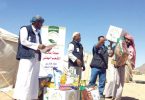By Tamjid alkohali
Life in the villages is a whole different ball game. The way of life for these people to an extent is simple, but to us outsiders it may seem difficult and for some normal. The people in our villages depend on themselves for every big and small task that has to be completed. Nowadays, women in our modern society are considered as what we would call “half of a society” because of all the eases that she is equipped with unlike women in the villages (rural communities) whom are not that fortunate thus having added agony. However, rural women are known to only eat from what they vegetate and to wear from what they produce, somewhat like the old days so they never lose the sense of tradition and custom. Although some aspects of their life may be difficult, rural women are without a doubt active, patient and strong.
To better inform us on the lives of rural women in our modern society, NationalYemen scheduled a trip to Bab al-Yemen to visit the Sanaany house, where we met Suad al-Mansour, whom works as a tour guide for the house.
On our tour, we saw each room within the house, to our surprise all the rooms still consisted of traditional and rural items. In the kitchen for example all of the tools were made of natural materials; things were done as if it was still the late 19th century. One of these tools known as “al-Rehaa”, a millstone used to grind grain was also in the kitchen, a tool that now has been modernized for easier use but the aspect of using a custom item is all the difference for these rural women.
Al-Mansour mentioned the tool stating that “in fact it is not easy to use al-Rehaa, it needs strong hands to make it spin fast so that it can grind the grain and have it soft”. He then continued to state, “With al-Rehaa woman can grind wheat, millet, corn, barley, or any other kind of grain to make bread and food, they also have control on the smoothness of the grain”.
As her first duty of the day, the rural women stands approximately a half an hour or more daily working with the millstone to prepare her flour and grain needs for the day. Al-Mansour compared life between the cities and rural places saying, “that city life is easier and faster than life in the villages, with the added bonus that life in the villages is much healthier, since people in villages depend and use everything from nature, illnesses and so forth are less common”.
According to Amt al-Rzaq Jhaf, the manager of the Sanaany house, the millstone consists of two round shaped pieces of stone, one is on top and the other is down and larger. In the middle of the stone, there is a hole for putting the grain; beside it there is wood piece used to move the upper stone in a circular motion. Opposite of the left side, there is another hole for distributing the grain.
“While the woman spins the stone, she uses her left hand to put in the grain gradually. Jhaf explained.
Nevertheless, Al-Mansour emphasized that the millstone cannot be found today in city markets, but it may exist within a few houses in old Sana’a, but not for use. Anyone looking for a millstone should request it to be made from people whom specialize in this field, called “Mouks” with the Yemeni accent.
The millstone or al-Rehaa is an important traditional use for all Yemenis in general, and old women in particular. Although old women may suffer from having to use al-Rehaa, we find a strong relationship between this tool and them, a sense of history and convention, and maybe the reason why this tool still exists in old houses today.


